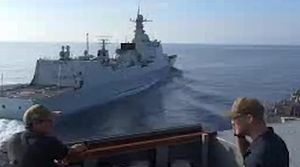Over the weekend, the Hong Kong-based South China Morning Post published the first video footage of a September 30 dangerous encounter in the South China Sea between a U.S. Navy destroyer and Chinese People’s Liberation Army destroyer. The footage, delivered to the Post by the British Ministry of Defense, shows the approach of the PLAN destroyer, a Type 052C vessel, the Lanzhou, toward USS Decatur, a U.S. Navy Arleigh Burke-class destroyer.
On September 30, USS Decatur conducted an innocent passage freedom of navigation operation within 12 nautical miles of several China-occupied features in the Spratly group in the South China Sea. The United States conducted operations of this kind starting in October 2015, when the Obama administration authorized the first known FONOP in the South China Sea within range of China’s artificial islands. The Decatur‘s operation came the day after the United States announced the approval of a possible sale of military aviation components to Taiwan and amid a general downsliding in bilateral relations.
The operations were designed to assert U.S. navigational rights in accordance with international law. The U.S. Department of Defense often has said that the U.S. Navy will fly and sail wherever international allows and these operations are carefully calibrated to assert legal rights. China has reacted with verbal indignation in the past and, otherwise, generally practiced safe navigational practice in trailing U.S. Navy vessels.
As The Diplomat‘s Steven Stashwick discussed, the near-collision incident between the Lanzhou and the Decatur was an unusually dangerous moment. The video released this weekend confirms Stashwick’s analysis that “Decatur was likely maintaining a steady course when the Chinese warship approached it in an attempt to force it off-course and induce it to leave.”
In the footage, the Chinese vessel can clearly be seen maneuvering to starboard ahead of the U.S. vessel. U.S. officials had noted that USS Decatur was forced to divert its innocent passage — which would otherwise have likely pursued the shortest possible path through the 12 nautical mile zone around Gaven Reef, where the incident took place — by evading collision with the Chinese vessel.
The Post‘s report also includes new audio and transcript data from the incident. What is particularly notable is the script adopted by the crew of the Lanzhou in issuing warnings to the crew of the Decatur. Since the October 2015 operation conducted by USS Lassen, Chinese and U.S. naval crews have been known to have professional — and occasionally cordial — comms chatter. The Lanzhou incident couldn’t be more different.
“You are on [sic] dangerous course,” the Lanzhou warned, per a UK Ministry of Defense document on the incident. “If you don’t change course your [sic] will suffer consequences.” That’s the strongest verbal warning issued by a Chinese warship to a U.S. warship in the South Chinat Sea that is yet to become public since October 2015, when these operations began. China has issued warnings to aircraft and vessels in the past, but never with the direct threat of undescribed — but presumably hostile — “consequences.”
As early as May 2015, the United States had publicized Chinese attempts to exercise control over artificial islands in the South China Sea by deterring U.S. overflight. Back then, the crew of a U.S. P-8A Poseidon maritime surveillance aircraft was warned away from Fiery Cross Reef, the site of a Chinese artificial island. The Chinese ground crew issued the following warning: “Foreign military aircraft. This is Chinese navy. You are approaching our military alert zone. Leave immediately.” The warning continued: “Please go away … to avoid misunderstanding.”
































